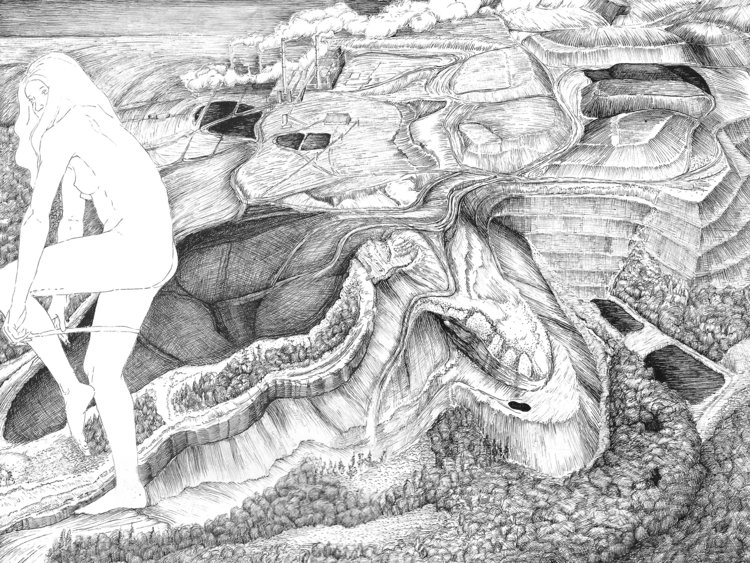
by DGR News Service | Aug 20, 2021 | Alienation & Mental Health, Biodiversity & Habitat Destruction, Climate Change, Human Supremacy, Mining & Drilling, Toxification
Editor’s note: In addition to running away from the unnormal normal this culture has created (which in my understanding means to stop identifying with the culture of empire which most people perceive as normal) we must take bold action to protect our only home, and the future generations who rely on us.
Featured image: “Strip” by Nell Parker
This article originally appeared on the blog By My Solitary Hearth.
By Eliza Daley
Central Vermont is under a heat advisory today. There is also smoke from fires on the opposite side of the continent, though rains are periodically washing it out of the sky. Thus sometimes we don’t have the air quality advisory to go with the heat, though last night I could see no Perseid meteors through the combined haze of smoke particulates and equatorial Atlantic humidity. In my small and rural county where around 83% of the eligible population is vaccinated, Delta variant cases are sending people to the hospital at roughly ten times any rate that has been seen in the previous eighteen months of pandemic. A local summer camp outbreak is at 25 sick kids and increasing. Local schools are scrambling to figure out how to pack our unvaccinated children back into classrooms in a few days with no good ideas and quite a lot of hand-wringing. My co-worker on a landscape job had to pull a dead rat out of an active well this week. And there are no tomatoes.
These are the headlines of ecological collapse. This is not normal. There will be no return to normal. Normal was not normal. Normal, as we defined it in the late 20th century, was an ecological aberration, unsustainable in every way. We were merrily gobbling up all the easily accessible resources, especially those that create the abundant energy necessary to gobble up the rest efficiently (meaning profitably, not practically). We dug up, concentrated, and synthesized poisons of all sorts, relying on the magnanimous Earth to scatter and diffuse the toxins, murdering billions of life-forms in the process, right down to the life-sustaining microbes in our own digestive tracts. We killed off much of the biosphere both intentionally — as in the case of insect population crashes due to widespread insecticide use — and accidentally — as in the heat-induced bleaching of coral that is collapsing ocean ecosystems worldwide. We harvested far more than we needed of nearly every natural resource and agricultural product in order to turn the biosphere into wealth for some humans. And we concentrated far too many of ourselves into geographical areas that can’t produce the means to meet our needs at all — but are remarkably good at meeting the needs of viruses and other agents of infection. This is what normal has created.
This overly-hot summer, I’ve seen far too many bleating demands to return to normal. They claim that we have to get back to working in the resource intensive and micro-managed environments of our bullshit jobs. We have to send our kids back to over-crowded classrooms and day-care centers, mostly so that we are then free to go back to the office. We have to fly and drive and spend money on tourism and the service industry. We have to buy stuff — though this last is somewhat muted because there are many ineradicable kinks in the stuff supply lines and there is much less stuff to buy. We have to go to the movies.
Yes, that was an actual New York Times opinion piece. A rather long complaint about the writer’s diminished movie-watching joy because he sat in an empty theater. He also complained about the recent lack of mob emotion at sporting events and music venues and a reduced capacity to gossip around the office water cooler. I think maybe this person needs some real social bonding so he doesn’t have to rely on these shoddy substitutions. However, it must be pointed out that this is the type of person with a New York Times publishing platform. A person in a privileged position of power, influence, and wealth who has such inferior family and friendship ties that he must seek out relief to his feelings of isolation in economic activity. This is what normal has created.
This is what normal has created. But it will not continue. It will not continue not because we will stop it. We are not stopping. We are bleating about our inability to get back to normal. We are endeavoring in every way to keep that normal churning out death and destruction and isolation. The most vocal among us, those with the most wealth and status and public reach, are not even looking to a world that does not include normal. But that world exists; that world is the real world that is ruining normal for us. And it is winning. Normal is not normal. Normal is not sustainable. And the world is showing us that this is true in no uncertain terms, no matter all bleating to the contrary.
Normal will end, probably has ended in spite of all our efforts and bleating, because it is artificial and unsustainable. Reality wins every time. It has taken a while in human terms (though almost no time in geological terms), but normal is losing. In smokey air that covers a continent, normal is revealed as the aberration it always was. In variant viruses that fill hospitals and sicken our children, we see that normal is failing. In the sad isolation that cries out for contact of any synthetic form, we know that normal is wrong.
This week there was a kerfuffle over the latest IPCC report, telling us what we already know of the death of our normal. We have heated the planet — through burning fossil fuels — past any hope of averting disastrous change. They do not use the hyperbolic language because they are not allowed to do so, but the message is quivering underneath their stolid words. They are telling us that the normal we created has destroyed itself. There is no evidence that we can save it. It was never real enough to perpetuate without nearly infinite resources fed into it daily to prop it up in the face of reality. There is nothing of our normal to save.
However, there is everything else. And for that everything, we must make some efforts. I’m not sure I agree with the IPCC findings, but they say there is still hope of saving something of this real world — with some mighty big IFs. IF we reduce our greenhouse gas emissions to net zero by 2050 and IF no tipping points are breached, we have about a random chance — a coin flip probability — of remaining below 2°C of warming and recovering a true normal in some century down the road. These big IFs incorporate some even bigger IFs. To reduce emissions to net-zero means that we need to remove carbon from the atmosphere — with technology that we do not have or natural draw-downs that we have not yet planted. Trees need time to root in and mature, time that does not remain in this IPCC budget. And as to tipping points, we’ve already seen accelerated rates of warming and melting in the polar regions. We’ve already seen population crashes that happen in a year or two. We’ve already seen crushing feedback loops that decimate large portions of the hydrosphere overnight. In other words, we’ve already seen intensification in rates of change that indicates without much doubt that we’ve already breached many known tipping points. The main point of doubt now is what surprises await us.
So I don’t know about the hope of the IPCC. What I do know is that we can all build our own small resilience, and in doing that we might be better able to both effect a carbon draw-down and save what we can of the real world — the world we depend upon. We are already imbedded in the real world. Our failing normal tells us this. If we stop making huge efforts to prop it up, it will go away entirely. Very likely it will go away rapidly. Collapse, when it does happen, is a tipping point. It is sudden and largely uncontrollable. It will hurt. But my suspicion is that it will hurt money and privilege more than it will hurt people and places — largely because our normal doesn’t benefit most people or places. It hurts them. It’s my hope that removing this hurt will balance out the hurt that collapsing normal might cause for most people. Money and privilege can bear the hurt — they are not even as real as normal.
I don’t know about the hope of the IPCC, but I do have hope still. Ironically, it comes from the very headlines that scare me, the very air that is cooking my body and choking me. These tell me that the normal we created is destroying itself rapidly. These headlines are also showing me that we probably can survive that destruction. Not all of us, not without pain, not without massive upheaval. But we are surviving. We are coming together to help each other. We are building new systems to support ourselves in the face of the collapse of the old ones. And large numbers of people are turning their backs on the bleaters. Because humans are a rather practical bunch when it comes down to it, and the practical solution is to run away from all this isolation and destruction and help each other. We’re very good at running away from pain. And at helping each other — as long as we’re not being constrained by artificial normals.
So I’ll bear the smoke and heat and diseases philosophically — though not without grumbling. And I think most of you will do the same. And together we’ll get through this. Mostly by running away.
But I just don’t know about the tomatoes…
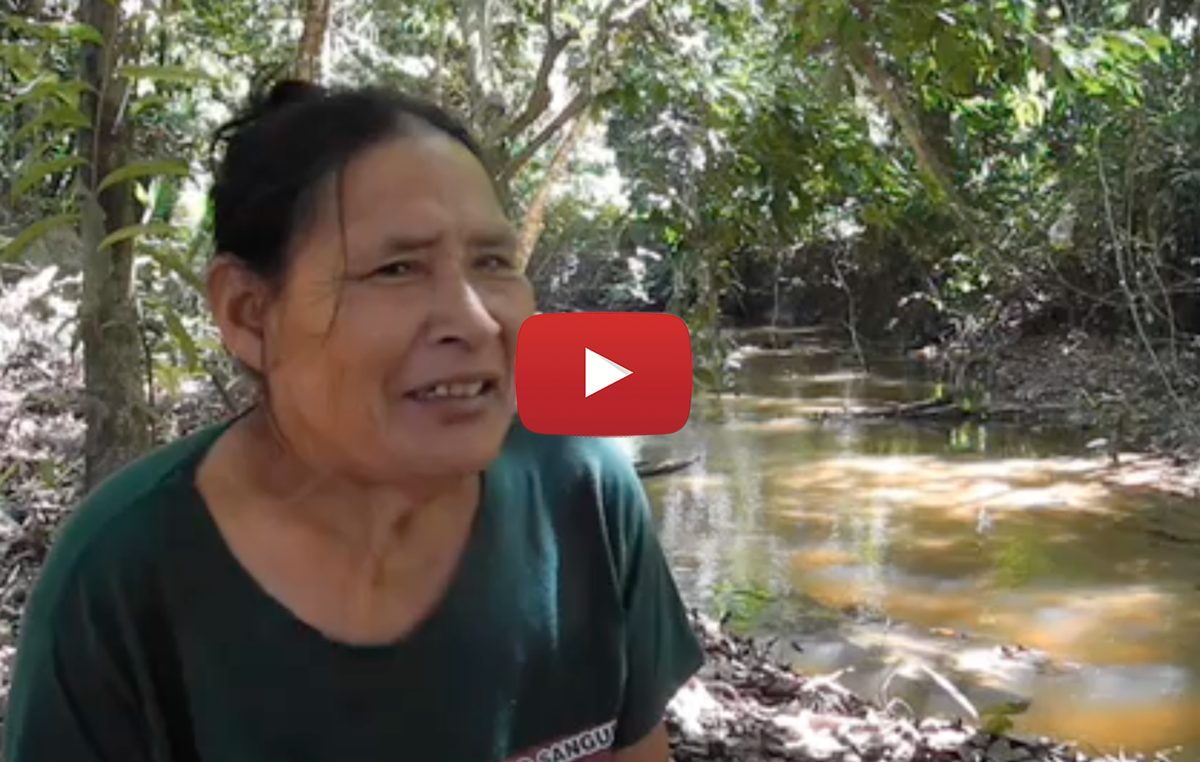
by DGR News Service | Aug 19, 2021 | Biodiversity & Habitat Destruction, Colonialism & Conquest, Indigenous Autonomy, Repression at Home
By Survival International.
Featured image: Rita Piripkura, the only contacted member of the Piripkura tribe. Her brother and nephew, Baita and Tamandua, are known to still live inside the territory.
© Survival
The only contacted member of the Amazon’s Piripkura tribe has voiced her fears that loggers operating illegally inside her people’s territory will soon kill her relatives.
Rita Piripkura is the only Piripkura person in regular contact with outsiders. In a unique interview released today by Survival International, she describes how nine of her relatives were massacred in one attack by loggers, and says that her brother and nephew, Baita and Tamandua, are known to still live inside the territory.
Rita says: “There are lots of land grabbers around… If they kill them, there won’t be anyone left.”
The Piripkura’s forest was deforested more than any other uncontacted tribe’s territory in Brazil in 2020. It is believed other members of the tribe are also living in the territory, having retreated to the depths of the forest.
The Piripkura’s forest is currently shielded by a Land Protection Order – an official order used to protect uncontacted tribes’ territories that have not been through the long process of official demarcation – but the order is due to expire on September 18.
A judge recently ordered the authorities to remove farmers and loggers inside the territory, but like most such edicts requiring government action, little has been done to comply.
Six other tribal territories are currently protected by similar Land Protection Orders, and in total they cover 1 million hectares of rainforest. But President Bolsonaro and his allies want to open up these territories, which remain vulnerable until they are fully demarcated as indigenous lands, as part of his government’s all-out assault on indigenous rights.
Sarah Shenker, head of Survival’s Uncontacted Tribes campaign, said today: “Rita Piripkura’s harrowing and urgent appeal for the survival of her relatives should be heard far and wide. The Piripkura people have been decimated by decades of killings at the hands of outsiders. Now those few that are left face the same fate, as ranchers and politicians, boosted by President Bolsonaro’s genocidal actions and proposals, are trying to rip up all protection of the Piripkura’s forest.
“The Land Protection Orders – and proper enforcement of them – are the only thing standing between uncontacted tribes like the Piripkura and total extinction. They must be renewed, all invaders evicted, and the land fully protected.”
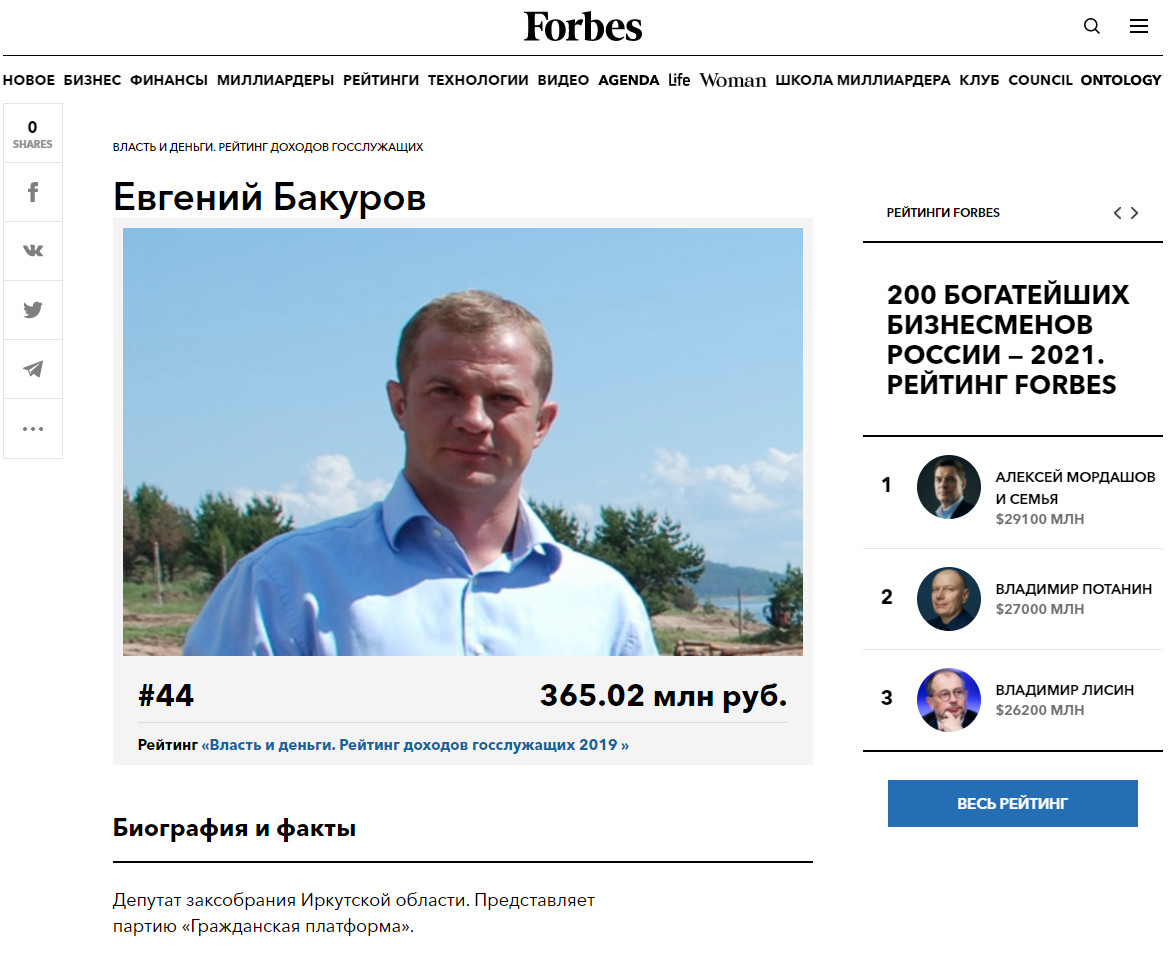
by DGR News Service | Aug 18, 2021 | Biodiversity & Habitat Destruction
- The world’s biggest furniture retailer, Ikea, has for years sold children’s furniture made from wood linked to illegal logging in protected forests in Russia, an Earthsight investigation has found.
- The brand’s popular Sundvik children’s range are among the items likely tainted with illegal wood. Investigators estimate that shoppers around the world have on average been purchasing an Ikea product containing the suspect Russian lumber every two minutes.
- Using undercover meetings, visits to logging sites, satellite imagery analysis and scrutiny of official documents, court records and customs data, Earthsight traced wooden furniture on sale in Ikea stores around the world to forests in Siberia, finding that they were controlled by companies owned by one of Russia’s wealthiest politicians, Evgeny Bakurov.
This article originally appeared in Mongabay.
Featured image: Evgeny Bakurov, one of Russia’s wealthiest businessmen-politicians, ranked 44th on a Forbes list of Russia’s highest-earning civil servants or legislators in 2019. Source: Forbes.ru / Earthsight
Ikea has allegedly been sourcing timber for its products from Russian companies engaged in illegal logging of pine trees in Russia’s protected Siberian boreal forests, a new investigation has revealed.
In a year-long probe by London-based investigative group Earthsight, the Swedish flatpack furniture manufacturer was the most well-known of several Western firms found to have sourced lumber for its products from ExportLes Group, a collection of companies owned by Evgeny Bakurov, one of Russia’s wealthiest businessmen-politicians.
Bakurov reportedly once boasted that an Ikea representative said the company chose to do business with him because he sent Ikea “logs faster than we can transfer the money.”
“Earthsight estimates that shoppers have been purchasing an Ikea product containing the suspect Russian lumber somewhere on earth every two minutes,” the group said.
Ikea said it had ended purchases from ExportLes in June after Earthsight shared its findings with the company, though it maintained the timber was “legally harvested” and said it had dropped Bakurov’s firm from its list of suppliers over unspecified “practices of concern”.
Russia’s boreal forests, also known as the taiga, include a majority of the world’s conifers and store about half of the northern hemisphere’s terrestrial carbon, so play a vital role in regulating climate change. The country is one of the world’s largest timber exporters, shipping almost a quarter of all lumber traded globally in 2019.
ExportLes had justified its logging of the trees in a protected area through a process known as “sanitary felling”, where loggers falsely claim trees are already dead, diseased, dying or damaged and so need to be cleared to preserve a forest’s health.
In late June, Ikea said it was placing a temporary ban on sourcing timber from firms engaged in “sanitary felling” in Russia’s Far East and Siberia.
Bakurov, a prominent figure in Russia’s Irkutsk region, had managed to secure the stamp of approval of the Forest Stewardship Council (FSC), the leading global sustainable timber certification body. Bakurov did not respond to the findings.
But Earthsight’s investigation alleges that the politician had signed several illegal deals to secure harvesting rights to more than 2 million cubic meters of timber in protected forests.
In response to the findings, the FSC denied wrongdoing but also invalidated Bakurov’s certifications.
According to the report, many of the trees entered the Ikea product chain primarily via an Indonesian manufacturer that supplies stores in western Europe and North America. Russian and Chinese intermediaries were also used.
Many of the products likely made with the illegal timber were marketed for children, the findings showed, with Earthsight drawing attention to the popular Sindvik line of children’s furniture.
A previous Earthsight investigation, published last year, linked the FSC and Ikea to the sale of illegally sourced wood from Ukraine.
“These are systemic problems, requiring systemic solutions, which go beyond one buyer, one supplier or one country,” Sam Lawson, Earthsight’s director, said in a statement. “Governments in Europe and the US need to act urgently to stem the flow of stolen wood once and for all.”
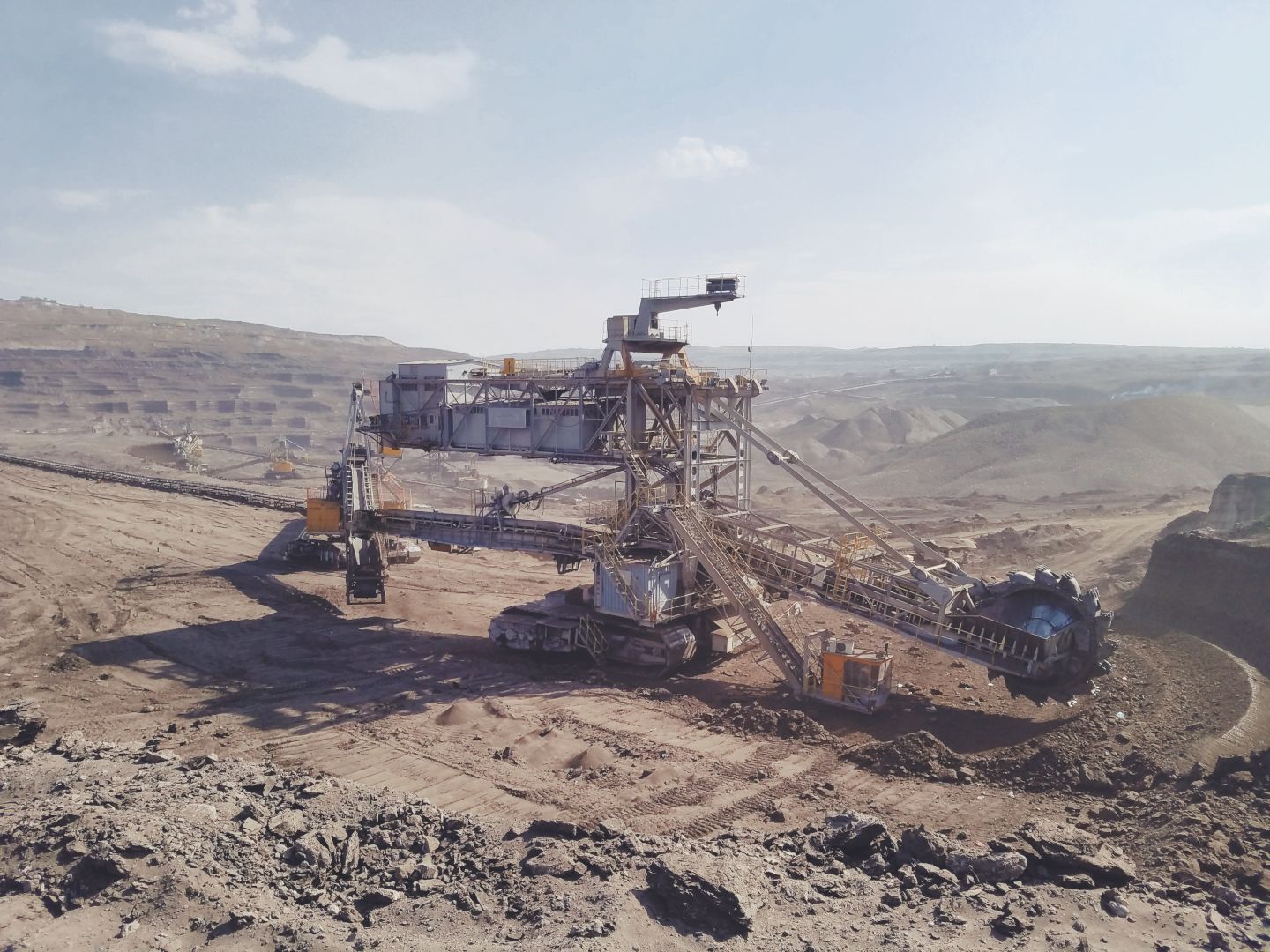
by DGR News Service | Aug 16, 2021 | Biodiversity & Habitat Destruction, Direct Action, Education, Mining & Drilling, Obstruction & Occupation, Reclamation & Expropriation, Strategy & Analysis, Toxification
A Guide for Resistance
By Carlos Zorrilla with Arden Buck and David Pellow
Resistance to mining is growing worldwide. Although extractive companies are powerful, they are also vulnerable.
About this guide
This guide is intended for leaders and organizers who can work with communities to carry out local actions, and who can also work at the regional, national, and international levels. It describes aspects of the mining process and the dangers your community faces when mining companies seek to operate in your community (Sect. 1), the many strategies you can use to fight back (Sect. 2 and Appendices A and B), examples of successful resistance by communities who fought back (Appendix C), and helpful resources in a companion volume (Supplement). Our hope is that with this guide, you too can succeed in protecting your community against these dangers.
This guide is not only for mining.
Most of the tactics and countermeasures described herein apply equally well to other extractive and exploitative activities: oil, gas, logging, various polluting industries, and large hydroelectric dams. Most activities proposed by large corporations, although they promise benefits, ultimately devastate local communities and their surroundings. If your community is targeted, it is essential to organize and resist. Acknowledgements: The material in this guide draws on the experience of several experts on mining and its impacts, particularly principle author Carlos Zorrilla. The guide came about because he realized that other communities around the world could benefit from the knowledge and experience that he and his colleagues gained while fighting to keep his area from being destroyed by mining companies.
Download the whole guide as PDF here:
Protecting Your Community From Extractive Industries
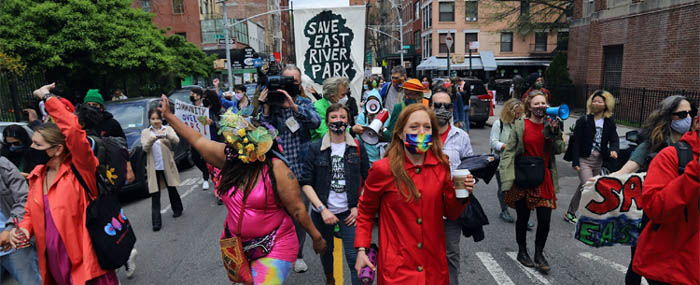
by DGR News Service | Aug 12, 2021 | Biodiversity & Habitat Destruction, Climate Change
Hurricane Sandy didn’t kill East River Park, but New York City is planning to.
Featured image: New Yorkers protest plan to bulldoze a thousand climate-saving trees.
This article originally appeared in Climate&Capitalism.
by Elliot Sperber
If you live in North America, chances are you haven’t just seen the hazy skies blanketing much of the continent this week, but have been breathing the toxic air, too. Blowing in from the monstrous wild fires devouring the forests out west, it’s more than just a reminder that our planet can’t continue to swallow the pollution we’re pumping into it; more than a reminder, it’s a presence that’s killing us.
And with Covid’s delta strain now spreading like an invisible haze, one that’s possibly spreading into our lungs as well, poor air quality (that euphemism for our most ubiquitous carcinogen) is something we certainly don’t need more of.
And while we can’t stop the wind, that doesn’t mean we’re entirely powerless to clean the air. The cheapest and most effective way, of course (in addition to curtailing pollution — i.e., degrowth), is to plant trees. Trees and other plants not only capture CO2, but produce oxygen. So, if we value breathing (and, really, only a maniac doesn’t, right?), we must also value trees. We should plant trees, as many as possible. But, crucially, we should also conserve the trees and forests and green spaces we have already. Those in positions of power who don’t value, and don’t prioritize, such vital resources are putting us all on a path to catastrophe.
That’s why it’s so peculiar that Bill de Blasio (the mayor of New York City, who never tires of promoting himself as a friend of the environment) among others are planning to destroy over one thousand mature trees in a park here this coming October. At a time when we should be protecting our trees and green spaces most vigorously, the city is intent on destroying the thousand trees of East River Park, the nearly one-and-a-half mile long park that runs between the East River (really a tidal strait, an extension of the bay, particularly prone to flooding) and the FDR Highway on Manhattan’s Lower East Side. But why?
When Superstorm Sandy arrived nearly nine years ago, its high winds and floods spread destruction and havoc throughout the region. Knocking out the ConEd power station at East River Park’s northern end resulted in major power outages over much of Manhattan. From midtown to its southernmost tip, Manhattan was without power for days. And though other parts of the city, such as the Rockaways, suffered worse and for far longer, it was this, along with substantial flooding in the Lower East Side, that led the U.S. Department of Housing and Urban Development to initiate a contest to find the best flood control and coastal resiliency project for the area.
The winning plan proposed to transform the 1.4 miles of East River Park into a new and improved park, with terraced fields and, importantly, a flood plain designed to absorb future flooding. This design not only preserved East River Park’s trees and green spaces. Part of the BIG U that was to wrap around all of lower Manhattan to protect it from rising seas, the proposal won wide support, including from the lower-income community of color that surrounds the park.
Altering the waterfront promenade to gently descend into the East River (to function as a flood plain), it would have also covered the FDR, creating a flood barrier over where that poisonous highway now roars. And because cars account for a great deal of the greenhouse gases heating, poisoning, and flooding us, the covered FDR was to be converted from a source of global heating into a mass transit corridor.
With widespread community support, the plan was adopted, but in 2018 it was suddenly scrapped. Bill de Blasio and his constituency, largely real estate developers, decided to pursue a different, nearly twice as expensive plan. They refused, however, to disclose why. And when the studies they relied on were finally made public, following a court order, much of it was blacked out. What are they hiding?
Among other things, de Blasio et al argue that their new plan protects the nearby ConEd energy plant. But, with all their secrecy, it’s more likely that saving the FDR and serving the real estate industry (i.e., making money) is their true motive.
This would hardly be unprecedented. Trees have been at odds with making money and power since this civilization’s earliest days. Even the ancient Babylonian Epic of Gilgamesh (c. 2100 BCE) includes an important episode in which the hero Gilgamesh, along with his companion Enkidu and the sun god Shamash, kills Humbaba, the protector of the Great Cedar Forest. And for what reason? In order to chop down the salubrious Forest (a use-value) and sell it for gold (exchange-value) and power.
This story illustrates a fundamental ambivalence inherent in the concept of value, one that inheres in the word itself. For value derives from the Latin word valere, which means strength; but this strength is defined both as health and as power. Among other places, this double even appears in the opening of the Old Testament, in the Garden of Eden. For the two trees, the tree of life and the tree of knowledge, express this duality of value, too. If, as Francis Bacon put it, knowledge is power, then the tree of knowledge corresponds to power; and for Bacon this is the power to “conquer and subdue nature.”
As for the tree of life, this is nature itself; the nature that the tree of knowledge would subdue, just as Gilgamesh subdued Humbaba. Importantly, the tree of life is also associated with health. The leaves of the tree of life are described by John of Patmos in the book of Revelation (22:2) as being medicine.
We could go on and on with this, and elsewhere I have. Needless to say, the point is that there’s a fundamental conflict between trees and gold which is at play here, too.
And while we may not know precisely why de Blasio and his rich friends scrapped the earlier accepted design for the park we do know this. Instead of a flood plain they plan to build a sea wall. Instead of repurposing the carcinogenic, global heating FDR, the new plan aims to save the highway, by bulldozing a thousand trees and 1.4 miles of gardens and fields, an amphitheater, historic buildings, playgrounds, all of it, and cover all 56 acres of the park in a billion tons of most likely highly toxic garbage (no one knows what the fill will consist of, or where it will come from) to raise the park. Then a new park will be built, 8 to 10 feet higher than the present park, atop this material.
New trees will be planted, they say. But it will be decades before these trees provide any shade, or produce much oxygen, or provide any relief to the community.
With the climate emergency upon us, this is no time to destroy trees, open space, parks, and public health, as the city plans to do. To be sure, if one values human and environmental health one will recognize that if anything needs to be destroyed it’s the FDR, among other highways. Trees, and human health, are clearly valuable as ends in themselves. The lethal, pollution-generating, space-eating cars and highways, on the other hand, are mere means, and poisonous ones at that. Just as the word insane stems from the Latin in (not) and sanus (healthy), it is literally insane to not shut down these ecocidal entities.
What will happen? Will the trees survive the bulldozers of progress? Will the waters rising all around us lead us to rise to this world historical occasion? We’ll see.
For more information contact East River Park Action.
Elliot Sperber is a writer, attorney, and adjunct professor who lives in New York City. He can be reached at elliot.sperber@gmail.com and on twitter @elliot_sperber
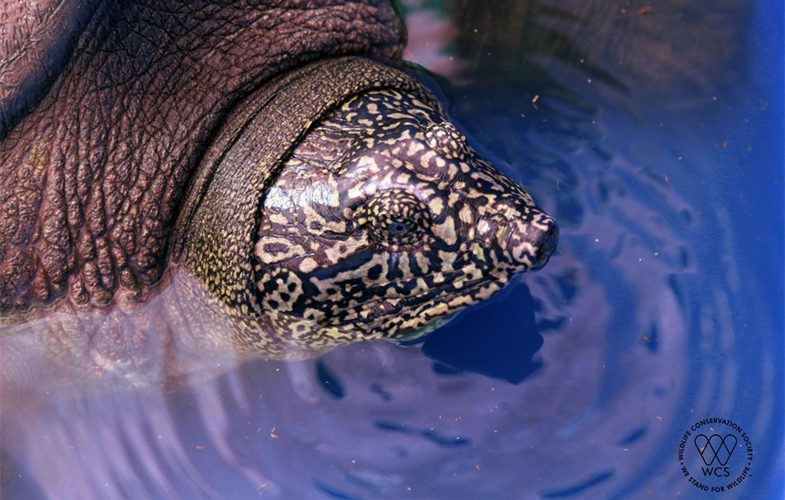
by DGR News Service | Aug 7, 2021 | Biodiversity & Habitat Destruction
A 500-year-old legend is key to the survival of a rare giant softshell turtle.
This article was produced by Earth | Food | Life, a project of the Independent Media Institute.
Featured image: The recently discovered female Rafetus swinhoei, caught and released in Viet Nam
By Hoang Bich Thuy and Nguyen Dinh Thang
Like many turtle species, Swinhoe’s softshell turtle (Rafetus swinhoei) has for centuries held special cultural significance in Viet Nam. For the people of the country, the Hoan Kiem turtle, as it is known locally, is a symbol of Viet Nam’s independence and prosperity. According to the legend passed from one generation to the next, this giant golden turtle emerged from the Hoan Kiem Lake to reclaim a magic sword used by the Le Loi King to defeat Chinese Ming forces in the 15th century. The lake was renamed Hoan Kiem Lake or Lake of the Returned Sword based on this legend.
But despite the Rafetus swinhoei being revered, it is also extremely threatened. For two decades it has been listed as “Critically Endangered” on the Red List maintained by the International Union for Conservation of Nature. Since 2013, the Rafetus swinhoei has also been listed in Appendix II of the Convention on International Trade in Endangered Species of Wild Fauna and Flora.
When two of the last remaining Swinhoe’s softshell turtles died without producing any known offspring between 2016 and 2019, this species became the most endangered turtle in the world. In response, conservationists and veterinary experts from Viet Nam, along with global partners, made the recovery of this turtle one of their highest priorities. Swinhoe’s softshell turtles were also included in the five-year conservation plan of Ha Noi People’s Committee in 2018 and added to the committee’s 2030 vision plan.
Then, in October 2020, a female turtle was captured in Viet Nam and confirmed by veterinarians to be a female Rafetus swinhoei. With the leadership of the Ha Noi Department of Agriculture and Rural Development, in collaboration with the Asian Turtle Program of Indo-Myanmar Conservation and our organization, the Wildlife Conservation Society (WCS), this imperiled turtle species may now have a second chance at survival.
The confirmation of Swinhoe’s softshell turtle in Ha Noi’s Dong Mo Lake means there is now a female in addition to a male, who is at the Suzhou Zoo in China. Authorities believe there are at least one more of these turtles in Dong Mo Lake and another in nearby Xuan Khanh Lake. Conservationists hope to capture and determine the sex of the other turtles in the coming months.
Ultimately, conservationists aim to help at least one male and female to breed to ensure that this species can return from the brink of extinction. The race to save this flagship species in Ha Noi highlights the importance of working in partnership to mobilize resources and address issues like water pollution, safer habitat, and more sustainable resource management. It also helps to replicate that success to save other species.
Task forces have been established to provide both the daily monitoring of turtles and the capture and preparation of other Swinhoe’s softshell turtles for a captive breeding program. Local fishermen have been engaged to monitor and capture the turtles, and have played a significant role and made a key contribution to Rafetus swinhoei conservation work.
At the same time, scientists are working to better understand the ecological role of this species. Researchers like Jeffrey Lovich of the U.S. Geological Survey have highlighted their importance to the seafloor biosystem, where they contribute by enriching soil nutrients and facilitating seed dispersion. The way in which river turtles—and specifically the Rafetus swinhoei—add value to their own ecosystems is an area that needs further study.
As WCS has worked to locate more Rafetus swinhoei individuals in the wild, we have come to better understand the ways in which habitat destruction has helped to push this turtle species to the edge of extinction: from water pollution to riverbed abrasion, to overexploitation for food and illegal trade.
A communication task force is now working with local communities to transition from harmful hook and electrical shock fishing methods to safer practices, and to rethink the way in which trash and pesticides are disposed into the sewage system, which eventually empties into the Dong Mo Lake, to help improve the quality of the lake water—especially during the low rain season. More work must be done to curb pollution from dump sites and golf courses into local waterways.
In Viet Nam, with the leadership of the Ha Noi People’s Committee, we are determined to take responsibility to give this cultural icon another chance. While overhunting and habitat destruction have contributed to its demise, our work confirms that the Hoan Kiem turtle and the centuries-old legend lives on.
With bad news and sadness from COVID-19, we feel hope by giving this species another chance to survive and to pass the symbol of prosperity to future generations in Viet Nam and around the globe.
Hoang Bich Thuy is the country director of the Viet Nam Program at the Wildlife Conservation Society.
Nguyen Dinh Thang is an information and design assistant at the Viet Nam Program of the Wildlife Conservation Society.






